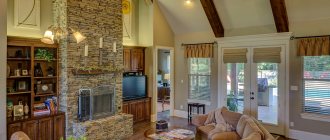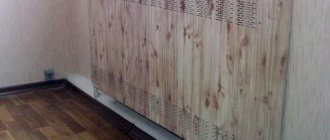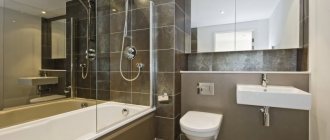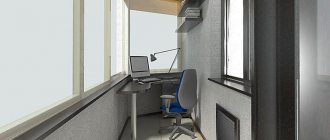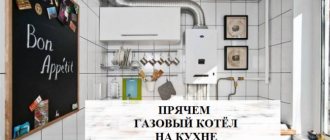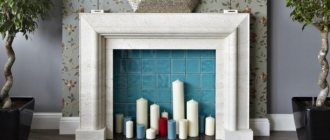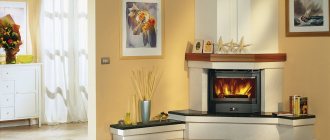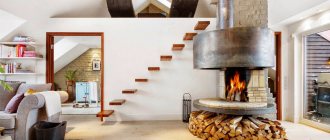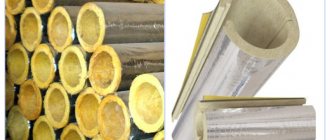To create a holistic interior, owners need to take care of all the details of the design of different rooms of the home. They should pay special attention to closing unattractive communications. We looked at the most convenient and practical options that will tell you how to decorate a pipe or hood. The work can use improvised materials or special building panels and sheets. Depending on the location of communication junctions, different types of decor can be used. It is also important to remember the requirements of government agencies, which may limit the number and type of solutions for different nodes. Having carefully considered all possible types of decoration, the owners will be able to choose an acceptable way to decorate communications without disturbing the overall design style of residential and non-residential premises in the house.
Preparing for work
Before carrying out work with the creation of false walls and boxes, you should take care of the communications themselves. Damaged elements or old connecting parts should be replaced with new ones. This way, it will be possible to prevent problems with their condition in the future. Small ventilation hatches must be installed above the heating elements. This will eliminate the possibility of moisture accumulation and poor-quality heating of the premises. Waterproofing should be done around or under water pipes. For this, thin roll materials or denser tile analogues cut to the size of boxes can be used. Their use will prevent the accumulation of moisture and the destruction of the finish and the appearance of mold. As for old metal communications, they should first be cleaned with sandpaper and covered with a new layer of paint (resistant to high temperatures and moisture).
Materials for making a scratching post with a bed
- two rectangles made of chipboard or other solid wood material (sizes are selected individually)
- two fiberboard rectangles (same dimensions as chipboard rectangles)
- pipe made of solid material (diameter 80-110 mm)
- rope (cotton, sisal, jute)
- foam rubber
- metal strip (width about 7 cm, length depends on the size of the bed)
- glue
- self-tapping screws
- metal corners
- faux fur or upholstery fabric
Decor features
Before you play with communications, you should take into account some of the features and requirements for them. For example, a gas pipe in a kitchen may not close completely. The best solution for it would be to decorate or paint it. In residential premises it is allowed to install false walls and boxes. If necessary, they can be supplemented with a mesh or grille for ventilation. Any materials can be used for finishing and assembly: they will not be subject to special influences. But in the bathroom it is necessary to use only those materials that can withstand high humidity. These include lining, moisture-resistant plasterboard sheets. To close vertical communications, you can use different solutions: cladding and decoration will not lead to a reduction in space. But horizontal communications should be closed only after careful consideration of available solutions. After all, even a small covering can lead to a limitation of free space.
Disguise using railing
For horizontal pipes that run low, just at the level of the kitchen apron, there is an excellent method of camouflage - imitation of a roof rail. It should be remembered that nothing can be hung on the pipe itself, so the supporting rail itself is attached above the gas pipe, which is painted in color.
Painting
Stylizing them using paint will help you create a catchy and unusual design for communications in any room of your home. Solutions in this direction can be divided into the following types:
- creating an accent. Excellent for heating systems in bedrooms and living rooms. For example, against the background of blue, turquoise, and purple walls, yellow and orange batteries and wiring will look striking.
- neutral design. For this method, the paint should be selected to match the finish used. The optimal solution for communications located in front of plain wallpaper, paint, and tiles.
- interior styling. To ensure that toilet wiring or wiring in a bedroom with colorful tiles or wallpaper stands out minimally, it is recommended to complement the plain painting with thematic patterns, ornaments or designs.
Using paint, you can stylize the vertical layout as wood in the hallway or children's room or living room. To do this, a crown is depicted on the wall, and the tubes themselves act as a trunk.
False walls
Installation of a false wall
Quite a radical, but still acceptable method of decorating pipes. Communications will not be visible behind the false wall, and for the radiator you need to make a niche, which can later be covered with a screen. Of course, the heat from the pipes will heat the air layer and only partially enter the room. The formation of an air gap is undoubtedly an advantage, since you can not only decorate the heating pipes, but also carry out additional insulation of the room from the inside, two in one. But if an accident occurs, the entire structure will have to be demolished.
By the way, the assertion that this will take away useful space is easily refuted. In fact, the volume of air in the room will decrease, but you will not feel it, since it is not the total volume of the room that is important, but the usable area. If there is a battery hanging on the wall under the window and, of course, there is a circuit connected to it, then you still won’t be able to use this space. And if you make a false wall, then you get the following benefits:
- communications are not visible;
- you can insulate the wall;
- slopes can be insulated;
- the window sill will be wider.
Decoupage
A simple way to decorate communications in a living room or dining room is to carry out decoupage. For it you can use decorative paper, newspaper and even napkins with small pictures. Doing the work yourself is quite easy and quick. To perform it correctly, you can use the following scheme:
- Clean the surface of communications with fine sandpaper. Remove dust using a stiff brush.
- Cover the communications with construction adhesive that is resistant to temperature changes and high humidity. It is recommended to do the work in stages: conditionally dividing communications into several parts.
- Place sheets of newspaper and napkins pre-cut to the diameter of the communications on top of the glue.
- Carefully process the attached materials using a flat, stiff brush, removing air bubbles and leveling the surface of the pattern.
- After the adhesive composition has completely dried, coat the paper materials with acrylic varnish with an increased degree of resistance.
Recommended Posts
Recently viewed by 0 users
No registered user is viewing this page.
10 small kitchens with a window sill-countertop
White kitchen in the interior: design tips and 70 stunning examples
Mediterranean style kitchen
The best articles on the IVD website
Are you a professional architect or designer?
Are you a professional architect or designer?
The IVD.ru website is a leading Internet project dedicated to the issues of reconstruction and interior design of residential premises. The main content of the site is the archive of the magazine “Ideas for Your Home” - exclusive author’s articles, high-quality illustrations, practical tips and lessons. A team of professionals is working on the project in close collaboration with famous designers, architects and leading publishing experts.
On our website you can choose comprehensive design solutions; view detailed reviews of the market for construction and finishing materials, furniture, machinery and equipment; compare your own ideas with design projects of leading architects; communicate directly with other readers and editors on the forum.
Are you a professional architect or designer?
Source
We use bamboo
The use of bamboo will help to decorate communications in the kitchenette, sanitary facilities and living room in a non-standard way. Hollow trunks with different diameters are sold in construction and gardening stores. It is recommended to select them by first measuring the diameter of the communications being designed. In this case, the internal diameter of the cavity of the selected bamboo should be at least 0.5 cm larger. Otherwise, there may be problems with their installation. It is quite easy to close communications with such columns. It is necessary to make 1-2 vertical cuts on the bamboo. And then just put it on top of the pipe communications. If necessary, one of the edges can be glued with glue for reliable fixation.
When choosing an interior element such as bamboo, it is worth considering the possibility of its integration into the overall appearance of the room. This solution will look appropriate against the background of light brown linoleum or wooden flooring or wooden walls. Fits well into oriental, Japanese style.
Decorating for apartment design
Masking a heating system is not always an annoying necessity. Such practical decor can serve as an additional decoration for the room. Just look at the photos of the finished options to be convinced of this.
If the design of the apartment is classic, or baroque reigns there, stucco molding is perfect as a disguise. The popularity of this method can be explained simply - this is an unusual design solution that complements the overall design of the apartment. In addition, stucco allows you to completely hide the structure.
If your apartment has a lot of wooden furniture, its color scheme is made in restrained tones, a lattice constructed from wooden blocks would be an ideal camouflage option. This original detail will not just hide the unsightly structure, but will give the apartment a more noble look.
If the now fashionable high-tech technology has “settled” in your apartment, the optimal solution for disguising the system would be a chrome-plated metal grille. This is a great addition to this modern and distinctive design.
You can see photos of ready-made solutions. Perhaps you will find an option that suits you completely. The main thing to remember is that when choosing a disguise, the decisive factor is not so much your personal preferences as the general style of the apartment. Decorative products should fit optimally into the interior design. Otherwise, having eliminated one, you will get another zone that is very noticeable.
Decoration options
- The structure can be tied with hemp or jute rope. In this case, the system will heat the room worse. However, possible heat losses are not significant;
- You can use bamboo trunks split lengthwise. From them you can build something like a casing;
- Crafters should like the idea of decorating the structure with artificial flowers;
- The areas where the structure meets the floor/ceiling can be decorated with decorative overlays that match the interior design of the apartment. They can also be installed in drainage areas from the riser;
- If you have a suspended ceiling installed, you can hide the cuts in it around the risers using decorative rings;
- You can make drapery from the material from which the curtains in the apartment are made.
There are many ways to decorate heating pipes. You yourself can easily come up with something new in this area. The main thing is imagination and determination to do quality work with your own hands. You can see the already camouflaged pipes in the photo. If you like any of the ready-made options, you can easily bring it to life.
Previously, during the construction of a house, communications were not hidden, as a result of which the premises acquired an unpresentable appearance. You can correct the situation if you find out how to decorate a heating pipe, especially since there are many such methods.
Draping with fabric
It is considered quite elegant to play up PVC and old metal vertical communications with fabric. This is an advantageous solution for living spaces or areas where cooking is carried out. Typically, translucent tulle is used to cover communications. The same canvases should be used to cover windows. You can completely copy the curtains on the windows and use both light and thick fabrics for draping the wiring. In order for the chosen method to look harmonious in the room, you should extend the cornice to the corner where the vertical communications are located and mount it next to them (on the adjacent wall). Thus, the floor-length canvases will cover not 1, but 2 walls at once. Thick canvases can be hung on one side of the window opening and near communications. Or you can use them near the pipe and on both sides of the window. The rest of the space is covered with translucent canvases.
How to hide pipes?
If the industrial style in the interior is not your choice, then exposed pipes in the house can become an annoying misunderstanding and an object of irritation. We list several solutions for masking them:
Important: before starting work, make sure the integrity of the pipe and, if necessary, repair or update it!
Pipes behind the curtains
Drywall boxes
The most popular and practical way. It is more convenient to make the box at the initial stage of repair, but it can be done later. If you don’t have the desire, skills or time, it’s easier to invite specialists.
Important: when closing heating pipes in boxes, be prepared for the heating of the room to decrease slightly.
Pipe box
Do not ignore creating a detailed design of the box - it will allow for more accurate installation. The design should not “eat up” a lot of space. To fit the box into the overall design, decorate it to match the wall decoration.
Idea: The facade of the box can be decorated with a patterned or lattice panel for ventilation and aesthetics.
Box for pilaster
Instead of plasterboard, chipboard, MDF, lining, polycarbonate, plastic panels, cardboard sleeve, etc. are used to cover the frame. When choosing materials, carefully read their pros and cons. Eg,
Chipboard contains harmful formaldehydes, MDF is heavy and expensive, and lining, without protection, is susceptible to rotting and rapid fire.
Construction of a false wall
It is convenient to zone rooms and hide household appliances and pipes behind it.
It consists of two plasterboard panels connected by a frame. An air gap remains inside.
Important: you cannot decorate the radiator and heating pipes with a solid “blind” panel - this will lead to heat loss and the development of fungus.
Pipe behind false wall
A false wall takes away at least 10-20 cm from the room. So why not increase its functionality? When covering the vertical heating pipe along the wall in the living room, consider illuminated niches and shelves for small items. A false wall in a bathroom with a door and shelves makes a practical cabinet for household chemicals.
A partition made of a false wall with elements of stained glass or glass covering the heating pipes will add special charm and elegance to the decor. If the structure is also illuminated, you will get an original night light, creating an atmosphere of comfort and romance.
Stained glass in the wall
Skirting
Wires have been hidden in baseboards for a long time. But it turns out that you can do the same with pipes running along the floor. True, they will require a baseboard that is more massive than usual, which will steal a little more usable space. But such a solution will give the interior a finished look without complex and costly construction activities.
Tip: the shade of the baseboard is matched to the color of the floor, doors or wall.
Pipes under the baseboard
The hollow profile of the plinth is easily fixed in the grooves of the mounting part and removed, which is convenient for pipe inspection. The optimal material for plinths is PVC, acrylic. It adequately withstands temperature changes in pipes, is moisture resistant, environmentally friendly, and resistant to mechanical damage (for example, when washing floors).
Tip: for better visual control of pipes and uniform heating of the room, use perforated screens made of aluminum and stainless steel.
Furniture
When ordering a kitchen set, provide a special false cabinet in which you can hide the pipe. Or upgrade your existing kitchen modules. For ventilation, make several holes in them in inconspicuous places or attach grilles.
False cabinet in the kitchen
Under the horizontal pipes at the top of the wall, you can hang a wide shelf and place kitchen utensils on it. This way the pipe will be almost invisible. In the case of a gas pipeline, the installation of the shelf is carried out extremely carefully.
Tip: To make the pipe less noticeable, paint it the same color as the wall or install a cabinet system underneath it.
In the bathroom, the pipes leading to the washbasin can be easily hidden by a cabinet or pedestal under the sink. An alternative option is to use curtains, baskets and boxes.
Vanity cabinet
Plastic panels
They tolerate moisture well and are easy to maintain, install and dismantle. They are often used in wet areas. A plastic screen can easily hide pipes of different sizes, shapes and directions. The process of its installation is reminiscent of installing a plastic ceiling with a mandatory base frame.
Tip: for a neater screen appearance without traces of fasteners, use decorative corners.
Plastic panels
A common budget option is to install a purchased or homemade plastic screen under the bathtub. Behind it you can hide communications related to both the bathtub and the sink. The free space behind the screen will provide additional storage space for household chemicals.
Bamboo trunk
It’s easy to let a piece of the tropical forest into your home, highlight the Japanese style, and at the same time decorate the chimney in an original way! Bamboo can help you. Having selected it to the required length, cleared of partitions, you need to cut it lengthwise and wrap it around the pipe. Then the cut areas are glued vertically or secured with rope to match the decor.
Tip: bamboo looks original when decorated with artificial or live plants, figurines of birds and animals.
Bamboo for pipe decoration
Roller blinds
It is practical and convenient to camouflage pipes in apartments using plumbing shutters. With them you get quick and complete access to the pipe along almost its entire length. Thanks to a wide range of designs and colors, roller blinds can be chosen to suit any interior style.
Roller blinds in the bathroom
Curtains and cornice
They will perfectly cover pipes located vertically along window slopes. There is no need to install anything special, because curtains and cornices are already needed. Curtains made of dense, non-transparent materials will cope more effectively with the task.
Advice: it is better to choose a cornice longer than the horizontal pipe, and with a projection slightly larger than its girth.
Cornice and curtains
In a bathroom or kitchen in Provence or country styles, pipes under the sink can be hidden with homemade draped curtains. Short curtains are also suitable for horizontal pipes under cabinets, shelves in a nursery, kitchen or laundry room.
Curtains under the sink
With ropes
The original decor of vertical and horizontal communications can be done with ropes. It is not recommended to use the cheapest jute ropes (with an uneven surface) for work, since they quickly become covered with dust and it is difficult to remove. But neat, smooth analogues made of jute (regular or dyed) are suitable for use in living rooms and toilets. Vertical layout using this material can be stylized as wood or palm tree. For such decoration, it is recommended to fix artificial greenery, branches with plastic lemons or oranges in the upper part of the braided communications.
In a small Khrushchev-era building, using thin ropes, you can create original marine decorations. White cotton ropes are suitable for the job. In this case, the horizontal wiring can not only be braided, but also decorated with flowing ropes. Additionally, small shells can be glued to the braid.
Removing the heating battery
The first thing to do is to remove the heating battery. Although a jumper (bypass) is installed in front of it, and by turning off the taps, you can dismantle it yourself, you still need to take one point into account. If the heating in the apartment is not turned on, then you can remove it yourself, but if the heating has already been turned on, then who knows what condition your ball valves that shut off the radiator are in. What if they become thinner over time? In this case, removing it yourself can turn into a big disaster for both you and your neighbors, and it would be better to call a professional.
It is necessary to prepare the site for future repairs, purchase the necessary materials and tools. Plus, call a technician to remove the battery and don’t forget to include time for the technician’s work itself. We plan for 1 day for everything.
After the wizard’s work, we will see the following possible picture:
Stained glass windows and furniture cornices
The use of non-standard solutions for styling an apartment and hiding gas, water, and heating communications makes it easy to transform living spaces and dining rooms. For vertical layouts it is recommended to use stained glass. They can be used to decorate living rooms, adult and children's bedrooms. Stained glass will not only cover communications, but will also become a stylish decoration. If you place a backlight behind multi-colored glasses framed by a wooden or similar body, the finished object will become an auxiliary lamp. In the case where communications are located at the top (ceiling placement), a beneficial solution would be to cover them with furniture cornices. They are installed along the side of cabinets, sets on top and fixed under the ceiling. At the same time, access to communications remains simple, and the space around them remains free.
Curly cornices will fit classic sets, but are unlikely to complement models with bright facades or chrome rails.
Use of kitchen furniture
Marking the pipeline and gas meter behind furniture facades requires much larger capital investments.
It is necessary to develop the design of the kitchen unit in such a way that vertical pencil cases and hanging cabinets are located in the appropriate places and heights. At the same time, the interior space of the cabinet can be used for storing utensils.
Drywall box
It is quite easy to close the exhaust ventilation duct and plumbing connections using drywall. From it you can assemble a structure of any shape and size, allowing you to change the layout of the room. In this case, all communications will be closed from prying eyes. This approach can also be used to hide chimneys. Work on assembling the structure is carried out as follows:
- Marking the sides of the structure relative to the closed communications. Requires taking into account the thickness of the plasterboard sheets used for work.
- Screwing guides and supporting profiles.
- Screwing plasterboard sheets (pre-trimmed) to the profile frame. For work in sanitary facilities, it is recommended to take moisture-resistant sheets, for residential premises - ordinary ones.
- Grouting and protecting seams, installing additional elements (corners, plumbing hatches)
- Finishing the structure with tiles, painting, wallpapering.
Decorative overlays
The junction of a pipe or plasterboard (plastic) box with the floor and ceiling is the most vulnerable: it is impossible to cut the edge so smoothly or lay down the floor covering.
When laying laminate flooring, it is even recommended to leave cutouts around the heating risers to avoid deformation of the flooring material itself when heated.
Therefore, decorative overlays are used to hide this unsightly place.
Advantages of use
Firstly, the overlays not only mask the joints, but also additionally decorate the room. Secondly, the practical benefits of the pads are obvious: during general cleaning or cosmetic repairs, they can be easily removed and then returned to their place.
Material of manufacture
As for the material, it is recommended to opt for wood. The service life of a wooden part is 10 years, in contrast to its counterpart made of MDF (medium density fiberboard) - it will last only 5 years.
The holes in the cover must exactly match the diameter of the pipe or the shape of the box, otherwise the whole point of this decoration will be lost. You can also consider plastic overlays.
Recommendations for decor installation
As a rule, these decorative trims consist of two parts, which are separated and, after installation around the heating element, snapped back together. After the decorative parts are installed, they are glued to the floor or ceiling.
Installation of this system is very simple and takes less than a minute. This decor can then be easily removed.
Laminate box, MDF
The assembly of structures from wood boards and similar materials is suitable for communications located above the baseboards leading to the basement. Their base should be assembled from slats. The use of timber and boards will allow you to quickly create a durable frame, complemented by a liftable MDF door or a fixed top. Using slats, you can assemble a completely removable structure. The top can be covered with laminate. The sizes and materials of different types of boxes are determined individually. The use of slats and laminate will result in significant costs. Wood boards and plywood will cost less, but their appearance will be simpler. Therefore, this type of box is recommended to be made for rooms where strict styling is not needed. The use of expensive laminate is mainly for rooms with a distinct stylistic direction (for example, modern, Provence, Scandinavian).
Finish price
Many people who have decided to decorate pipes in their apartments have a question about which method is the most economical.
Answering this question, we can immediately talk about painting. If, for example, you choose alkyd enamel as a painting material, then a can will cost you no more than 200 rubles. Drywall is also an available material for decoration. The cost of sheets of this material starts at 200 rubles. But they alone will not be enough to decorate heating pipes. You will also need profiles, the average price tag for which starts from 50 rubles. also need skirting boards , the cost of which starts from 20 rubles.
In order for the plasterboard structure, behind which the pipes are hidden, to look aesthetically pleasing, putty is necessary. Prices for such compositions start from 100 rubles. If you decide to build a false wall, then in this case you will have to spend much more on material. You can't get by with drywall. also need , prices for which start at 150 rubles. for 1 sq. m. You will also need screens for radiators, which cost 300 rubles in stores.
You can also decorate heating pipes in an apartment by using jute rope. This material is quite inexpensive. The maximum price for it is 120 rubles. for 1 linear meter. also use hemp rope , prices for which vary from 10 to 880 rubles. The most expensive method is stained glass. If you choose this option for decorating pipes in your apartment, you will have to pay several thousand rubles for this pleasure.
False wall
In a situation where the pipework is large and creating a small box will not solve the problem, you should make a full-fledged false wall. It is assembled from profiles and plasterboard sheets. It is recommended to supplement the created ledge with a plumbing hatch. This will allow owners to easily access communications and repair or replace them. In plumbing rooms, the false wall may be non-standard. To do this, boxes are assembled on the left and right, and plumbing roller shutters are hung on top of them. This solution will allow you to instantly gain access to the wiring, eliminate the leak and carry out a complete replacement of communications without delay. The false wall itself can be covered with wallpaper or painted or tiled. Moisture-resistant plasterboard sheets should be used as a base.
